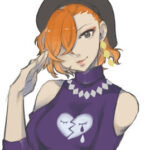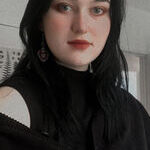So here we are on the final day of this year’s Women in Horror Month! It’s been a bit of a whirlwind, since many of the celebrations came together so quickly in the last week or so of February. But it’s been a wonderful occasion to see all of the incredible accomplishments of women writing and working in the horror genre today!
To finish up the month, I asked a group of phenomenal women in horror to tell me all about their favorite female villains. The answers were of course incredibly varied and insightful. From Jennifer Check in Jennifer’s Body to fearsome matriarch Cathy in East of Eden, here’s a wide array of villainous ladies to watch out for!
 FRIDAY ELLIOTT: My favorite female villain is Villanelle from the TV show Killing Eve. She’s the rare example of a sociopathic character with an emotionally complex inner world. I love her shameless hedonism and attachment to luxury by her own definition, and she’s a totally unique take on the “sexy evil assassin/spy” archetype.
FRIDAY ELLIOTT: My favorite female villain is Villanelle from the TV show Killing Eve. She’s the rare example of a sociopathic character with an emotionally complex inner world. I love her shameless hedonism and attachment to luxury by her own definition, and she’s a totally unique take on the “sexy evil assassin/spy” archetype.
 CAROL GYZANDER: Annie Wilkes, in Stephen King’s Misery: A Novel, is hands-down my favorite female villain. After all, she totally supports her author and encourages his writing because she is his ‘NUMBER ONE FAN’! So I axe you, isn’t she awesome?
CAROL GYZANDER: Annie Wilkes, in Stephen King’s Misery: A Novel, is hands-down my favorite female villain. After all, she totally supports her author and encourages his writing because she is his ‘NUMBER ONE FAN’! So I axe you, isn’t she awesome?
 KYLE TAM: My favorite female villain in horror is a bit of an off-kilter one – the villainess protagonist of Torture Princess, Elizabeth le Fanu. She has a bloody history behind her, a villain who is deployed to destroy other villains. Both noble and violent, both monstrous and almost heroic, she’s a controversial figure both in and out of universe and I love her to bits!
KYLE TAM: My favorite female villain in horror is a bit of an off-kilter one – the villainess protagonist of Torture Princess, Elizabeth le Fanu. She has a bloody history behind her, a villain who is deployed to destroy other villains. Both noble and violent, both monstrous and almost heroic, she’s a controversial figure both in and out of universe and I love her to bits!
 ANGELA SYLVAINE: My favorite female horror villain is Jennifer Check from Jennifer’s Body, the sacrificial victim turned monstrous demon. I love her because she uses her sex appeal to lure men, only to feed on them. She’s also, in my interpretation, a messy bisexual who is complicated and imperfect. She clearly loves and is attracted to her best friend, Needy, but is also jealous and wants to hit her where it hurts.
ANGELA SYLVAINE: My favorite female horror villain is Jennifer Check from Jennifer’s Body, the sacrificial victim turned monstrous demon. I love her because she uses her sex appeal to lure men, only to feed on them. She’s also, in my interpretation, a messy bisexual who is complicated and imperfect. She clearly loves and is attracted to her best friend, Needy, but is also jealous and wants to hit her where it hurts.
 FRANCESCA MARIA: Lilith. I love Lilith because she was born equal to man, not made from a portion of his being. She is completely independent in her thoughts and acts solely based on her own will and needs.
FRANCESCA MARIA: Lilith. I love Lilith because she was born equal to man, not made from a portion of his being. She is completely independent in her thoughts and acts solely based on her own will and needs.
 MORGAN SYLVIA: I have to go with Nancy from The Craft. Not only was this one of the most iconic performances ever, it’s also a fascinating take on the perils and repercussions of using power for greed.
MORGAN SYLVIA: I have to go with Nancy from The Craft. Not only was this one of the most iconic performances ever, it’s also a fascinating take on the perils and repercussions of using power for greed.
Now I want to go rewatch it for the gazillionth time…
 L.E. DANIELS: After a hot tip from Geneve Flynn, I’m preoccupied with Lady Maeda, played by Claudia Kim, in the South Korean Netflix series Gyeongseong Creature set in Seoul during the Japanese occupation in 1945. Lady Maeda is complex, cunning, and utterly spotless in her silk couture as she quietly rules this male-dominated era. Through horror, the series is a social exorcism of the real-life war crimes committed to the Korean people during this period by the Japanese and once again, shows us how emotionally informed and truthful horror can be. Even the conclusion to Lady Maeda’s character arc is surprising and achingly beautiful, and she will inhabit me for some time.
L.E. DANIELS: After a hot tip from Geneve Flynn, I’m preoccupied with Lady Maeda, played by Claudia Kim, in the South Korean Netflix series Gyeongseong Creature set in Seoul during the Japanese occupation in 1945. Lady Maeda is complex, cunning, and utterly spotless in her silk couture as she quietly rules this male-dominated era. Through horror, the series is a social exorcism of the real-life war crimes committed to the Korean people during this period by the Japanese and once again, shows us how emotionally informed and truthful horror can be. Even the conclusion to Lady Maeda’s character arc is surprising and achingly beautiful, and she will inhabit me for some time.
 CATHERINE JORDAN: My favorite female villain is the female cenobite, a former nun—Sister Nikoletta—who became obsessed with sin. Her character is dark and mysterious and there’s so much about her that I want to know. As a writer, there’s more that I’d like to explore.
CATHERINE JORDAN: My favorite female villain is the female cenobite, a former nun—Sister Nikoletta—who became obsessed with sin. Her character is dark and mysterious and there’s so much about her that I want to know. As a writer, there’s more that I’d like to explore.
 KC GRIFANT: The Xenomorph Queen in Aliens. She is ruthless, intelligent and resourceful. And she’ll do whatever it takes to ensure her offspring survive!
KC GRIFANT: The Xenomorph Queen in Aliens. She is ruthless, intelligent and resourceful. And she’ll do whatever it takes to ensure her offspring survive!
 EMMA MURRAY: Cathy Ames from East of Eden by John Steinbeck. On one hand, she’s a fascinating portrait of psychopathy: unable to feel the normal depth of emotion but learned to imitate them to manipulate others, always behaving callously selfish, and utilizing her beauty and ability to charm to use then discard everyone around her. On the other hand, she’s a force of feminine rage in a patriarchal saga, and though she definitely acts malevolently, I’m always impressed with how she goes against everything a woman is expected to be in that time and place.
EMMA MURRAY: Cathy Ames from East of Eden by John Steinbeck. On one hand, she’s a fascinating portrait of psychopathy: unable to feel the normal depth of emotion but learned to imitate them to manipulate others, always behaving callously selfish, and utilizing her beauty and ability to charm to use then discard everyone around her. On the other hand, she’s a force of feminine rage in a patriarchal saga, and though she definitely acts malevolently, I’m always impressed with how she goes against everything a woman is expected to be in that time and place.
 DESTINY KING: Annie Wilkes defies Stephen King’s stereotypical female roles, acting as a dual-sided figure who challenges gender norms and Gothic conventions. While she exhibits nurturing and even wife-like traits, she is also dark, abusive, and dangerously volatile. Her history as a serial killer, revealed through a chilling scrapbook, culminates in one of horror’s most iconic torture scenes.
DESTINY KING: Annie Wilkes defies Stephen King’s stereotypical female roles, acting as a dual-sided figure who challenges gender norms and Gothic conventions. While she exhibits nurturing and even wife-like traits, she is also dark, abusive, and dangerously volatile. Her history as a serial killer, revealed through a chilling scrapbook, culminates in one of horror’s most iconic torture scenes.
 JAN STINCHCOMB: It’s a tie (if that’s allowed) between Mrs. Danvers of Rebecca (1938) and Mary Katherine Blackwood––Merricat––of We Have Always Lived in the Castle (1962).
JAN STINCHCOMB: It’s a tie (if that’s allowed) between Mrs. Danvers of Rebecca (1938) and Mary Katherine Blackwood––Merricat––of We Have Always Lived in the Castle (1962).
They’re both coming from similar places, in that their evil acts are informed by a perverted sense of love and family loyalty. Mrs. Danvers is caught in a love relationship with a dead woman she would kill for, while Merricat strives, after committing multiple murders, to preserve a solitary life with her beloved sister. Place plays a huge role in the lives of both characters: Manderley for Mrs. Danvers and the Blackwood house for Merricat. Both sites are doomed, as are these characters. I love them because of the cursed, uncompromising intensity of their emotions.
 ABIGAIL WALDRON: Countess Marya Zaleska is the protagonist/antagonist of Dracula’s Daughter (1936). Despite being written in the 1930s, her character remains complex to this day and is a vessel for queerness. Sadly, the Countess is quite self-loathing, wishing away her vampiric urges. However, by film’s end, she becomes a true antihero for spooky lesbians everywhere. Long live the Countess!
ABIGAIL WALDRON: Countess Marya Zaleska is the protagonist/antagonist of Dracula’s Daughter (1936). Despite being written in the 1930s, her character remains complex to this day and is a vessel for queerness. Sadly, the Countess is quite self-loathing, wishing away her vampiric urges. However, by film’s end, she becomes a true antihero for spooky lesbians everywhere. Long live the Countess!
 MAY WALKER: Typically, I’d follow the rules and choose one character, but these characters have decided to hold hands in my mind. I love a good backstory, but in the case of Virginia Merrye from Spider Baby, and Elaine Parks from The Love Witch, it’s all about performance, and the shift from prey to stalker. These enchanting women stand out for the unapologetic pursuit of their desires, of which one is love, ranging from romantic, to the unconditional familial variety, to the glee of playing spider.
MAY WALKER: Typically, I’d follow the rules and choose one character, but these characters have decided to hold hands in my mind. I love a good backstory, but in the case of Virginia Merrye from Spider Baby, and Elaine Parks from The Love Witch, it’s all about performance, and the shift from prey to stalker. These enchanting women stand out for the unapologetic pursuit of their desires, of which one is love, ranging from romantic, to the unconditional familial variety, to the glee of playing spider.
 CLAIRE L. SMITH: I am team ‘Carrie White did nothing wrong’. I watched (and later read) Carrie when I was first getting into horror and it was the first instance I’d seen where the villain of a horror movie wasn’t some masked killer but a victim that flipped the tables on her abusers. The moment she finally snaps after one last brutal act of humiliation from her peers is so horrifying but oddly vindicating in a perfect ‘good for her’ moment that will forever stick with me.
CLAIRE L. SMITH: I am team ‘Carrie White did nothing wrong’. I watched (and later read) Carrie when I was first getting into horror and it was the first instance I’d seen where the villain of a horror movie wasn’t some masked killer but a victim that flipped the tables on her abusers. The moment she finally snaps after one last brutal act of humiliation from her peers is so horrifying but oddly vindicating in a perfect ‘good for her’ moment that will forever stick with me.
 CHLOE SPENCER: Jennifer Check from Jennifer’s Body! One thing that I love about Jennifer is that although she uses her powers to terrorize and murder others, in a way, she’s also reclaiming her autonomy. Jennifer takes her beauty, which has been weaponized against her, and turns it into her own weapon in order to take down her prey.
CHLOE SPENCER: Jennifer Check from Jennifer’s Body! One thing that I love about Jennifer is that although she uses her powers to terrorize and murder others, in a way, she’s also reclaiming her autonomy. Jennifer takes her beauty, which has been weaponized against her, and turns it into her own weapon in order to take down her prey.
 MAE MURRAY: Abigail. I just enjoyed the hell out of watching that little vampire torment her would-be captors! Alisha Weir’s performance as the immortal ballerina, alternating between helplessly sweet and gleefully merciless, makes her an all-time female villain and movie monster. Move over Megan, because there’s a new dancer in town, and she’s classically trained to beat your ass.
MAE MURRAY: Abigail. I just enjoyed the hell out of watching that little vampire torment her would-be captors! Alisha Weir’s performance as the immortal ballerina, alternating between helplessly sweet and gleefully merciless, makes her an all-time female villain and movie monster. Move over Megan, because there’s a new dancer in town, and she’s classically trained to beat your ass.
Tremendous thanks to our women authors for sharing their favorite villains!
Happy reading, and happy Women in Horror Month!
